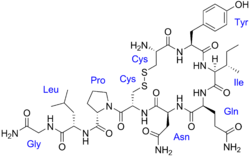Oxytocin receptor agonist: Difference between revisions
←Redirected page to Oxytocin receptor#Agonists Tag: New redirect |
←Removed redirect to Oxytocin receptor#Agonists Tags: Removed redirect Disambiguation links added |
||
| Line 1: | Line 1: | ||
[[File:Oxytocin with labels.png|thumb|right|250px|[[Oxytocin]], an example of an oxytocin receptor agonist.]] |
|||
An '''oxytocin receptor agonist''' is a [[chemical compound|compound]] that acts as an [[agonist]] of the [[oxytocin receptor]].<ref name="pmid34550574">{{cite journal | vauthors = Nashar PE, Whitfield AA, Mikusek J, Reekie TA | title = The Current Status of Drug Discovery for the Oxytocin Receptor | journal = Methods Mol Biol | volume = 2384 | issue = | pages = 153–174 | date = 2022 | pmid = 34550574 | doi = 10.1007/978-1-0716-1759-5_10 | url = }}</ref><ref name="pmid30509888">{{cite journal | vauthors = Gulliver D, Werry E, Reekie TA, Katte TA, Jorgensen W, Kassiou M | title = Targeting the Oxytocin System: New Pharmacotherapeutic Approaches | journal = Trends Pharmacol Sci | volume = 40 | issue = 1 | pages = 22–37 | date = January 2019 | pmid = 30509888 | doi = 10.1016/j.tips.2018.11.001 | url = }}</ref> Examples include [[peptide]] oxytocin receptor agonists like [[oxytocin]], [[demoxytocin]], and [[carbetocin]] and [[small-molecule]] oxytocin receptor agonists like [[TC OT 39]], [[WAY-267464]], and [[LIT-001]].<ref name="pmid34550574" /><ref name="pmid30509888" /> Oxytocin receptor agonists are used medically to [[labor induction|induce labor]], [[galactogogue|promote lactation]], and for other uses.<ref name="pmid20626426">{{cite journal | vauthors = Viero C, Shibuya I, Kitamura N, Verkhratsky A, Fujihara H, Katoh A, Ueta Y, Zingg HH, Chvatal A, Sykova E, Dayanithi G | title = REVIEW: Oxytocin: Crossing the bridge between basic science and pharmacotherapy | journal = CNS Neurosci Ther | volume = 16 | issue = 5 | pages = e138–56 | date = October 2010 | pmid = 20626426 | pmc = 2972642 | doi = 10.1111/j.1755-5949.2010.00185.x | url = }}</ref> In addition, oxytocin receptor agonists are of theoretical interest for the potential treatment of [[social disorder]]s, such as [[autism]] and [[social anxiety]].<ref name="pmid34550574" /><ref name="pmid30509888" /> Small-molecule oxytocin receptor agonists are considered to be more promising for such uses due to better [[pharmacokinetic]] profiles, such as [[blood–brain barrier]] [[permeability]] and [[elimination half-life|elimination half-lives]].<ref name="pmid34550574" /><ref name="pmid30509888" /> |
|||
==References== |
|||
{{Reflist}} |
|||
{{Oxytocin and vasopressin receptor modulators}} |
|||
[[Category:Oxytocin receptor agonists]] |
|||
{{Genito-urinary-drug-stub}} |
|||
{{Nervous-system-drug-stub}} |
|||
Revision as of 04:08, 10 April 2023

An oxytocin receptor agonist is a compound that acts as an agonist of the oxytocin receptor.[1][2] Examples include peptide oxytocin receptor agonists like oxytocin, demoxytocin, and carbetocin and small-molecule oxytocin receptor agonists like TC OT 39, WAY-267464, and LIT-001.[1][2] Oxytocin receptor agonists are used medically to induce labor, promote lactation, and for other uses.[3] In addition, oxytocin receptor agonists are of theoretical interest for the potential treatment of social disorders, such as autism and social anxiety.[1][2] Small-molecule oxytocin receptor agonists are considered to be more promising for such uses due to better pharmacokinetic profiles, such as blood–brain barrier permeability and elimination half-lives.[1][2]
References
- ^ a b c d Nashar PE, Whitfield AA, Mikusek J, Reekie TA (2022). "The Current Status of Drug Discovery for the Oxytocin Receptor". Methods Mol Biol. 2384: 153–174. doi:10.1007/978-1-0716-1759-5_10. PMID 34550574.
- ^ a b c d Gulliver D, Werry E, Reekie TA, Katte TA, Jorgensen W, Kassiou M (January 2019). "Targeting the Oxytocin System: New Pharmacotherapeutic Approaches". Trends Pharmacol Sci. 40 (1): 22–37. doi:10.1016/j.tips.2018.11.001. PMID 30509888.
- ^ Viero C, Shibuya I, Kitamura N, Verkhratsky A, Fujihara H, Katoh A, Ueta Y, Zingg HH, Chvatal A, Sykova E, Dayanithi G (October 2010). "REVIEW: Oxytocin: Crossing the bridge between basic science and pharmacotherapy". CNS Neurosci Ther. 16 (5): e138–56. doi:10.1111/j.1755-5949.2010.00185.x. PMC 2972642. PMID 20626426.
